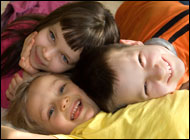Children’s sleep disorders missed by pediatricians
The rate at which sleep disorders are diagnosed in infants, children, and adolescents is well below prevalence reported in epidemiological studies, indicating that these conditions are not being recognized by primary care pediatricians, investigators reported this week at SLEEP 2009, the 23rd annual meeting of the Associated Professional Sleep Societies.
“We know that sleep problems are very common based on community studies, but do not know how frequently they are being diagnosed in pediatric primary care practices,” lead author Dr. Lisa Meltzer told Reuters Health.
To investigate, Dr. Meltzer and associates conducted a chart review for all well-child visits in 2007 at the 32 primary care pediatric practices affiliated with the Children’s Hospital of Philadelphia. Included were records for nearly 155,000 patients from birth to 18 years.
“We found that all sleep disorders, including those that are less of a concern, such as bedwetting and sleepwalking, and those that are more serious, including obstructive sleep apnea, insomnia and narcolepsy, are being underdiagnosed in primary care practice,” the researcher noted.
“If identified and properly treated,” she continued, the illness cause by “these sleep disorders can be significantly reduced. However, untreated sleep problems can impact every aspect of children’s lives, including growth, learning, attention, mood, and family functioning.”
 She advises primary care pediatricians to routinely ask about the child’s sleep during every well-child visit, since “children typically do not outgrow sleep problems, and for most sleep disorders there are empirically validated and effective treatments.”
She advises primary care pediatricians to routinely ask about the child’s sleep during every well-child visit, since “children typically do not outgrow sleep problems, and for most sleep disorders there are empirically validated and effective treatments.”
These include behavioral interventions for bedtime problems and night wakings in young children and removal of the tonsils and adenoids for obstructive sleep apnea.
Meltzer noted that the most common symptoms that signal the need for a polysomnographic study, in which the brain waves are monitored over night during sleep include snoring, gasping, witnessed apneas, and excessive daytime sleepiness.
Furthermore, she concluded, “given that obstructive sleep apnea is a serious concern and can be effectively treated, the American Academy of Pediatrics has recommended that all children who snore be evaluated for sleep disordered breathing.”
By Karla Gale
NEW YORK (Reuters Health)